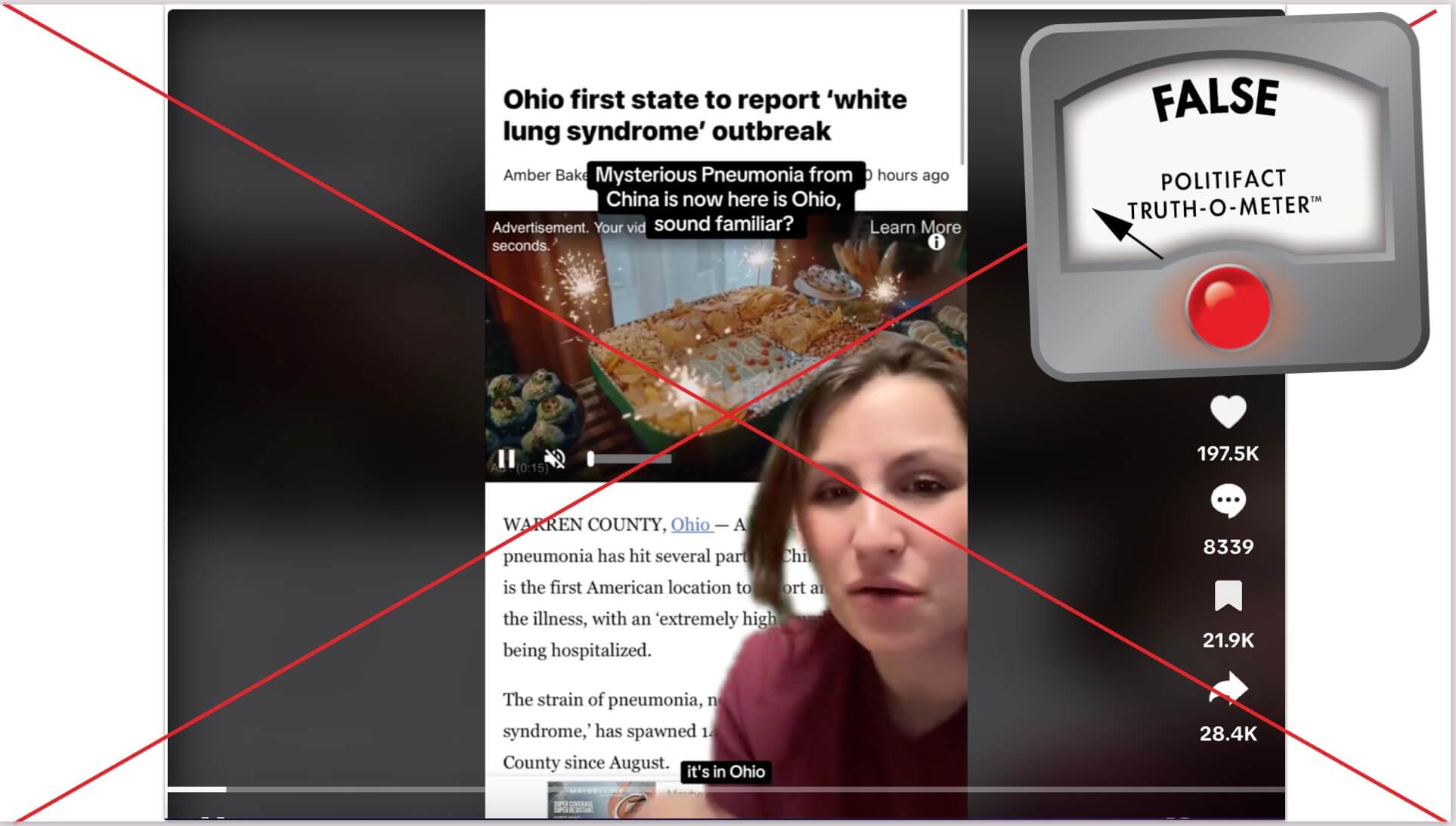A recent uptick in pediatric pneumonia cases in one Ohio county led some social media users to falsely claim the cases are tied to a similar rise in respiratory illnesses in China.
“Mysterious pneumonia from China is now here in Ohio. Sound familiar?” read sticker text on a Nov. 30 TikTok video that has been liked more than 198,000 times.
A woman in the TikTok read aloud from an article on the website of WTRF, a West Virginia TV station that also covers Ohio. The article tied the Ohio outbreak to the China outbreak, describing a “mystery outbreak” in China it said is called “white lung syndrome.”
“I feel like we’ve seen this movie before. We did this, and I don’t think that we can do it again,” the woman in the TikTok said, an apparent reference to the COVID-19 pandemic.
TikTok identified this video as part of its efforts to counter inauthentic, misleading or false content. (Read more about PolitiFact’s partnership with TikTok.)

(Screenshot/TikTok)
A Dec. 1 Instagram post made similar claims.
Although the pneumonia cases are similar — stemming from typical respiratory pathogens — the outbreaks in Ohio and China are not connected. Each outbreak is caused by known pathogens, not new ones, health authorities and experts said. Despite concerns in media reports and among U.S. politicians about the “mystery” outbreak in China, experts said the fact that it’s caused by a known pathogen means there is no mystery.
What’s happening in China?
China has had a recent rise in respiratory illnesses, primarily among children, the World Health Organization said in a Nov. 22 statement. The WHO said it requested more information from China after media reports “about clusters of undiagnosed pneumonia in children’s hospitals.”
After speaking with Chinese authorities, WHO said in a Nov. 23 post that data showed that multiple known pathogens caused the increase. Cases since May have been linked to Mycoplasma pneumoniae, a common bacterial infection, and cases since October have been linked to respiratory syncytial virus, adenovirus, and influenza. No new pathogens have been detected or identified in China, WHO said.
Centers for Disease Control and Prevention Director Mandy Cohen echoed that explanation at a Nov. 30 House subcommittee hearing.
“We do not believe this is a new or novel pathogen. We believe this is all existing, meaning COVID, flu, RSV, mycoplasma,” Cohen said, answering a question about China’s rise in respiratory illnesses.
The Ohio outbreak
The Warren County Health District in Ohio said in a Nov. 29 press release that an “extremely high number of pediatric pneumonia cases” had been reported this fall. The district said it did not think the outbreak was from a new respiratory disease, “but rather a large uptick in the number of pneumonia cases normally seen at one time.”
There was no common thread linking the illnesses, the district’s news release said. Mycoplasma pneumoniae, Streptococcus pneumoniae and adenovirus — all known pathogens — were among the pathogens found.
In a Nov. 30 follow-up press release, the district said there were 145 reported cases of pneumonia in children ages 3 to 14 since August. There were no deaths reported, and the severity of the cases is similar to past years, it said. Most children are treated with antibiotics and recover at home.
The CDC said Dec. 1 on its website that the respiratory illnesses among children in the U.S. “do not appear to be due to a new virus or other pathogen, but to several viral or bacterial causes” that are common during the respiratory illness season.
“The current rise in respiratory disease cases in the United States is normal for this season,” CDC spokesperson Jasmine Reed told PolitiFact. “CDC is in touch with local health authorities and its country office in China. We continue to monitor the situation, collaborating with global health partners.”
The Ohio Department of Public Health said in a Dec. 8 statement to PolitiFact that it doesn’t have statewide counts of pediatric pneumonia cases. Outbreaks, such as the one in Warren County, are reportable to the state, but individual cases of pneumonia without specific identified causes are not. The department pointed us to a CDC webpage that shows respiratory virus activity across Ohio is minimal.
No connection between China, Ohio
There is no evidence the Warren County outbreak is connected to outbreaks elsewhere, the health district said.
The Ohio and China cases aren’t linked, but each is caused by the same factors, said Dr. Céline Gounder, an infectious disease specialist and editor-at-large for public health at KFF Health News.
“Young children were less exposed to respiratory infections during the pandemic and so did not develop immunity. They are now being exposed to influenza, RSV, COVID(-19) (and) Mycoplasma and are getting sick,” said Gounder, who was a guest at this past autumn’s PolitiFact-led United Facts of America conference.
Gounder cited “especially tight and long social distancing” in China, and said the U.S. saw a similar increase in RSV cases last year after COVID restrictions were eased.
Dr. Shira Doron, chief infection control officer for Tufts Medicine and associate professor at Tufts University School of Medicine, agreed with Gounder.
“If there was a new pathogen, you would not expect to see infection predominantly in children. Seeing infection affect children more than adults means that it’s an issue of ‘immunity debt,’” Doron said. That means children haven’t been exposed to the pathogens they normally would and that adults have been exposed to many times.
What is ‘white lung syndrome’?
Though several news reports and social media posts described the cases as “white lung syndrome,” that is not a medical term, Gounder said.
“When someone has ARDS (acute respiratory distress syndrome), the lungs on a chest X-ray look white,” Gounder said. “ARDS is a syndrome, not a specific infection or disease. It’s like saying pneumonia.”
Doron said ARDS is not what’s arising in Ohio or China or anywhere else.
“I do not know who decided to insert that scary phrase into a headline,” Doron said, “but I read a lot of articles to try to figure it out, and not a single doctor or scientist used it. It is not a term doctors in the US would use.”.
Our ruling
A TikTok video claimed a “mysterious pneumonia” from China is now in Ohio.
There have been similar increases in pediatric pneumonia cases in China and one Ohio county, but the outbreaks aren’t connected. Both outbreaks are caused by known pathogens that commonly circulate this time of year, not a new pathogen.
We rate the claim False.
This fact check was originally published by PolitiFact, which is part of the Poynter Institute. See the sources for this fact check here.






